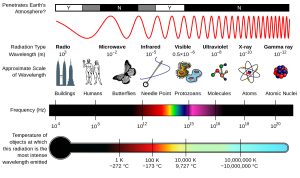Since the discovery of X-rays at the end of the 19th century, they have been widely used in medical imaging, research, and engineering due to their unique penetrating power and imaging capabilities. This article will discuss the definition of X-rays, frequency, wavelength, and a comparison with Gamma rays.
X-Ray Definition
X-rays are a form of electromagnetic radiation, manifesting in different forms based on their wavelength. In certain wavelength ranges, they appear as visible light, while in others, they take the form of invisible radiation such as ultraviolet rays, infrared rays, and X-rays. X-rays, like visible light, belong to the electromagnetic spectrum but have shorter wavelengths and higher energy.
The full name of “X-ray” is X-radiation, where the letter “X” represents the unknown. This naming was given by Wilhelm Röntgen, who discovered these rays in 1895 by accident. He found that they could penetrate objects and leave images on photographic film. Since the exact nature of these rays was not known at the time, Röntgen named them “X-rays”.
Due to their short wavelengths and high energy, X-rays can easily penetrate most materials. As a result, they are widely used in medical diagnostics (such as BMD X-rays and dental imaging), security inspection (like airport baggage scanning), material science, industrial testing (such as weld defect detection), and scientific research (such as crystal structure analysis).
X-Ray Wavelength and Frequency
The electromagnetic spectrum consists of seven primary types of electromagnetic radiation, arranged from longer to shorter wavelengths: radio waves, microwaves, infrared rays, visible light, ultraviolet rays, X-rays, and gamma rays. Electromagnetic waves propagate in the form of waves with peaks and troughs, and the distance between two adjacent peaks or troughs is called the wavelength. Compared to visible light, radio waves have longer wavelengths, lower frequencies, and lower energy, while X-rays have shorter wavelengths, higher frequencies, and higher energy.
X-rays fall between ultraviolet rays and gamma rays on the electromagnetic spectrum. They are electromagnetic waves with extremely short wavelengths and very high energy. The wavelength range of X-rays is from 0.01 nanometers to 10 nanometers, and their frequency range spans from 30 petahertz (PHz) to 30 exahertz (EHz) (i.e., 3×10¹⁶ Hz to 3×10¹⁹ Hz). Their energy range is from 100 electron volts (eV) to 100 kilo-electron volts (keV). The energy of X-rays is higher than ultraviolet rays but lower than gamma rays. Due to their high-energy characteristics, they are widely used in medical imaging and industrial testing.
Gamma vs X-ray
Both gamma rays and X-rays are forms of electromagnetic radiation.
X-rays are typically produced by high-speed electrons striking a metal target (such as a tungsten target) and are capable of penetrating tissues, bones, and metals. They are widely used in medical imaging, such as chest X-rays, mammography, and dental X-rays.
Gamma rays, on the other hand, are produced by the decay of atomic nuclei or nuclear reactions and generally have higher energies than 100 keV, often reaching the MeV range. They can penetrate even thicker and denser materials, including concrete and thick leather.
Application Differences:
In the medical field, gamma rays are less common in routine imaging due to their higher energy, but they are used in cancer treatment with gamma knife therapy. This therapy precisely targets cancer cells deep within the body, but it requires careful control to avoid damaging healthy tissue.
In industrial testing, X-rays are commonly used to inspect defects in welds, castings, and other materials. Gamma rays, with their superior penetrating power, are better suited for detecting corrosion and structural defects in large equipment (such as pipes and vessels).
Are There Risks?
Although X-rays have made significant contributions to medicine, industry, and other fields, their ionizing radiation can pose potential safety risks to the human body. Prolonged or high-dose exposure may cause cellular damage, increase the risk of cancer, and have adverse effects on the reproductive system and fetal development.
When using X-ray equipment, it is crucial to follow safety protocols:
- Control radiation doses and avoid unnecessary repeated exposures.
- Wear personal protective equipment, such as lead aprons and lead gloves.
- Enhance shielding measures to ensure equipment meets radiation protection standards.
- Regularly monitor operators’ radiation doses to ensure exposure stays within safe limits.
- Conclusion
Conclusion
With the continuous development of technology, the applications of X-rays will expand further, and our understanding of them will deepen. X-rays remain indispensable in various fields, and ongoing research will continue to unlock their potential while ensuring safe use.










